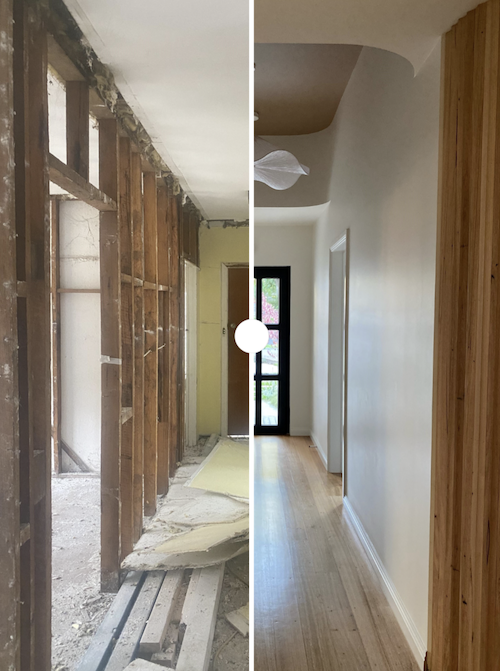How a Passivhaus Renovation Transformed this Leaky Cottage into an Energy-efficient Home
Pictured: Tylah Ingram and Dylan Farquhar - Credit: ABC
This article first appeared on ABC.
Love, loss and drama. Tantrums, tears and success — you'd be forgiven for thinking Tylah Ingram and Dylan Farquhar's home renovation was part of a TV drama script.
While many might've looked at their rundown, weatherboard-clad house — complete with leaky roof — as a knockdown rebuild, Tylah and Dylan had other plans.
Using the bones of their 1950s cottage in Melbourne's east and Dylan's skills as a builder, their goal was to turn it into a modern passive home.
What is a Passivhaus?
Passive homes are incredibly energy efficient and need little to no heating or cooling
They're designed to reduce the amount of thermal energy that leaves or enters a house
While electricity bills may be smaller, passive houses are more expensive to build
The pair became inspired after staying in a passive house, and Dylan became so interested he set out to make building them his craft.
"It was just a real eye-opener to say that everything I'd been taught, I'd have to throw out and start again," he told ABC TV's Grand Designs Transformations.
To work effectively, passive houses need to be comprehensively insulated and sealed and have windows that are, as a minimum, double-glazed.
The result is an incredibly energy-efficient house with stable internal temperatures and small or non-existent energy bills.
They can also include a mechanical ventilation system to bring fresh air into the house, reduce humidity and filter out dust and other allergens.
Both the exterior and interior of the house was redone. Credit: ABC
"This is the only way we should be building houses," Dylan said.
"Anything else is going to be at risk of mould and condensation and poor health, potentially, to the occupants."
A Tight Budget and Timeline
While it might be better for your health and hip pocket in the long term, building a passive house can be considerably more expensive than a normal house thanks to the specific materials needed and the extra time it takes.
"In early meetings with architects we basically got laughed out of the room when we shared our budgets," Dylan said.
Undeterred, the pair threw themselves head first into the project, relying on their ability to do the bulk of the work themselves to help their bottom line.
To save on living costs and rent, they also sacrificed their personal space by moving into an 18-square-metre portable studio at the back of their block with their Weimaraner, Moose.
"Oh, there's been numerous tears and meltdowns — on my behalf," Tylah said on living in the tiny space.
"When it's raining, it gets pretty grim," Dylan added.
Credit: ABC
It's no wonder the couple were keen to move into slightly bigger digs as soon as possible.
They set a goal of completing their passive transformation in nine months for $600,000.
"It's still going to be a push to get to that finish line," Tylah said.
And, if that wasn't chaotic enough: "We've got to squeeze in a wedding in there as well," Dylan added.
Hard Work Begins
As well as installing all the necessary features to make it passive, Tylah and Dylan's plans also involved substantial changes to the home's interiors, including:
Re-doing the mouldy ceilings
Revamping the bathroom and kitchen
Adding an extension at the back for a light-filled lounge room
Despite the level of renovation and work needed, Dylan and Tylah's focus on sustainability meant knocking the cottage down and starting again was never on the table.
Credit: ABC
"There's a lot of embodied energy that goes into new building products so to be able to reuse what we can … you're having a lot less impact on [the environment]," Dylan said.
Re-using materials during the project extended to restoring as many of the original weatherboards, floorboards and other materials within the house as possible.
Tylah, a landscape architect, also had big plans for the front and back garden, including an entertaining area and lots of room for Moose to run around.
After ripping up floorboards, smashing out walls, and removing the ceiling, Dylan and Tylah installed the features needed to help control the temperature of their new home.
Given the name of the game in a passive house is to make sure it's airtight, the project involved a lot of gaps being taped up and staples to secure the internal and external seals.
Credit: ABC
"On average, we're using 15,000 staples across the project," Dylan said.
"I think we're on target for about three kilometres worth of tape.
"If you have more than five per cent of gaps within your insulation layer, your performance drops 50 per cent."
The Air Leak Hurdle
Before Dylan and Tylah could get stuck into renovating the rest of the interior, the house had to pass a "blower door test" designed to assess its airtightness.
Air was sucked out of the house, and then the amount of air that leaked back in through gaps or other holes was measured.
For their house to qualify as passive, it couldn't exceed more than 0.6 air changes per hour (ACH).
For comparison, a normal house would rack up about 15 to 25ACH.
"Yeah feeling a little nervous," Dylan said as he and Tylah gathered to watch the test.
The result? A painfully close 0.7ACH.
"It's a lot higher than where we want it to be," Dylan said.
"I'm predicting there's a dramatic leak somewhere."
Using a thermal image camera, a couple of substantial leaks were found and quickly patched up before the test was run again.
This time around, the result was 0.43ACH, which was met with much relief and celebration.
"That's really good," Tylah said.
"It means that we can then progress to the next stage and plaster it knowing that we're already hitting that target that we need."
Love and Tragedy
Their passive project wasn't the only emotional rollercoaster Tylah and Dylan had to contend with.
Outside of their renovation, life delivered a few exceptional highs and lows of its own.
In the middle of the build, the pair tied the knot, surrounded by their friends and family.
Not long after, though, their beloved dog Moose suddenly passed away.
"This whole project has been amazing, but the point of this project was to create a family home and Moose is part of the family," Tylah said.
"That part has been lost and it's really affected us.
"I just keep thinking on how it was meant to be with him."
Tylah said continuing their renovations without Moose was devastating.
"We are empty and heartbroken he will not be here to enjoy our lives with us," she said.
"We're embarking on doing the landscaping and how it was meant to be with him."
The Finish Line
It took three months longer and $50,000 more than they'd anticipated, but Tylah and Dylan's passive house and garden makeover became a reality.
Aside from enjoying the fruits of their labour, the pair said there were a few specific parts of the house they have been loving.
"It's so worth it, the amount of comfort that you feel in this home, it's wild," Tylah said.
"It's just nice not to be like wondering if it's going to be freezing cold when you come home from work — or boiling hot."
Tylah and Dylan also found it confronting to see the amount of material their filters (AKA "the lungs of the house") stopped from ending up in their house.
"We changed them after two months of being in the house, and the amount of pollution and dust and stuff that isn't coming into this house — they were black," Tylah said.
"It was so satisfying to see that and just be like, 'Wow, we actually live in a really clean home.”
Dylan said the health benefits of passive homes are not often spoken about.
"It's hard to collect any data on how many times you're not going to the doctor now because you're not getting colds in winter," he said.
Is a Passivhaus for you?
Tylah and Dylan acknowledge that building or retrofitting a house to be passive is out of a lot of people's budgets.
But they pointed out that if a passive home is something you want to pursue, it can be broken up into smaller, manageable chunks.
"You can stage it," Dylan said.
"If you know that's going to be your forever home — you love the spot, you've got cool neighbours, whatever it is — maybe do the windows and the wall envelope year one, and then do the roof year three.
"If it takes five, 10 years, at least you know the retrofit's futureproof and you can stay there forever."
Congratulations to Tylah and Dylan on their success despite many challenges along the way — a truly inspiring story.
This article first appeared on ABC.






